
(Photo: Jonathan Maus/BikePortland)
If you thought Portland’s U.S. Congressman Earl Blumenauer was done pushing bicycle policy on Capitol Hill with his bikeshare and bike-to-work tax credit bills; you don’t know Congressman Blumenauer.
Yesterday his office made official something we teased in the Monday Roundup: Blumenauer has teamed up with Representative Jimmy Panetta, a Central California Democrat, to introduce the Electric Bicycle Incentive Kickstart for the Environment (E-BIKE) Act. The bill seeks to give a strong push to EV-bikes in America. Despite not having the rebates or purchase incentives of EV-cars, people are flocking to bike shops to buy electric bikes in record numbers.
Advertisement

The E-BIKE Act (PDF) would create a tax credit that covers 30% of the cost of an electric bike, up to $1,500 (or $3,000 for joint returns). It’s applicable to bikes costing under $8,000, and is fully-refundable, allowing lower-income workers to claim the credit.
According to the bill text (PDF), the credit can be applied to e-bikes that have pedals, a saddle, a motor of less than 750 watts and that meet one of the three-class definitions: class 1 (20 mph max with no throttle), class 2 (20 mph max with throttle), or class 3 (28 mph max with no throttle). The credit can also only be used on new bikes. And if you’re building a fleet of e-bikes, you can only claim the credit for one bike (or two for joint returns).
Panetta and Blumenauer framed the legislation as a way to replace car trips and reduce carbon emissions:
“A recent study found that if 15 percent of car trips were made by e-bike, carbon emissions would drop by 12 percent. 46% percent of e-bike commute trips replaced automobile commute trips according to a recent North American survey, and a more thorough review of European studies showed that e-bike trips replaced car trips 47% to 76% of the time.”
It’s notable that a strong, broad-based coalition has already joined the lawmakers to support the bill. Major bicycling and environmental advocacy groups have teamed up with one of the largest e-bike makers in the world to make sure the bill is signed into law. The coalition includes:
– PeopleForBikes
– League of American Bicyclists
– California Bicycle Coalition
– Bike Santa Cruz County
– Bicycling Monterey
– Ecology Action
– CALSTART
– U.S. PIRG
– The National Resources Defense Council
– Gazelle Bikes
– Current eBikes
Advertisement
“America’s car-centric transportation system is wreaking havoc on our health and the health of our planet… As we move through the COVID-19 crisis, we urge policymakers to not only accommodate e-bike adoption, but to actively encourage it,” said John Stout, a transportation advocate with U.S. PIRG.
And Ewoud van Leeuwen, GM of bike maker Gazelle USA, said the bill could take America one step closer to a northern Europe-like future: “Increasing the adoption of e-bikes in the US will have a positive and transformative impact on cities, quality of life, and how people relate to one another, similar to what we have seen in the Netherlands.”
Federal incentives would be a boon for EV-bikes in the U.S. Here in Oregon, our robust electric car incentive programs do not include bicycles. Oregon House Bill 2165 would expand rebates available through the Charge Ahead program and H.B. 2179 would add electric tractors to the rebate program; but neither effort includes e-bikes.
— Jonathan Maus: (503) 706-8804, @jonathan_maus on Twitter and jonathan@bikeportland.org
— Get our headlines delivered to your inbox.
— Support this independent community media outlet with a one-time contribution or monthly subscription.







Thanks for reading.
BikePortland has served this community with independent community journalism since 2005. We rely on subscriptions from readers like you to survive. Your financial support is vital in keeping this valuable resource alive and well.
Please subscribe today to strengthen and expand our work.
The difficulty is that the eBike supply chain is very stretched right now.
Raw materials used to make bikes are up 40%. Shipping containers cost 3x more than a year ago and the US dollar is falling in value internationally.
a 30% rebate is extremely helpful, but please understand that prices are going up and it might end up being an offset for the price increases…
That is partly true. Given current inelastic supply, increased demand from the tax credit will push prices up, effectively shifting much of the benefit to suppliers – but not fully offsetting the tax credit (Google Cost Incidence for more info on how this works). Additionally, this tax credit will likely outlast the current supply constraints, so in the longer term it will heavily benefit consumers.
The dollar falling is a good thing for domestic manufacturing.
Super agree with ebike store. This bill has to come with a sleuth of deregulation measures to support the bike industry.
This is a common sense policy. If the federal government can allot a tax credit of $7500 for an electric luxury, sports car (see Porsche Taycan – http://www.fueleconomy.gov/feg/taxevb.shtml) , then it can cough up a few hundred bucks for an ebike, which will do more to benefit low and middle-income taxpayers, public health, the environment and traffic to boot.
This is very cool — thank you for sharing Jonathan! There are some significant equity considerations with this bill (you don’t get a tax credit if you don’t owe taxes, which some lower income folks don’t, so it’s really not an incentive for them). But given that Oregon isn’t budging on this issue right now, the Federal action is a great place to legitimize it!
On top of the issues you mentioned, you also have to spend $5,000 to get the full benefit, which is more than what ~95% of ebike models cost (and probably 99% by unit volume). A higher match of 50% would make this more equitable.
Re: “you don’t get a tax credit if you don’t owe taxes,”
That’s incorrect. You can get a tax credit if you file taxes, even if you don’t owe taxes. The Earned Income tax credit work this way. (But you do have to file taxes to claim it, so there is some barrier to getting it.)
https://www.hrblock.com/tax-center/filing/credits/difference-between-tax-deduction-and-tax-credit/
Is that true for the credit proposed here? What you are saying is true for some tax credits, including the EITC and I believe education tax credits, but it is not always the case. I haven’t looked up the specifics of subpart C of part IV or subchapter A of 1 of the IRC of 1986, which is amended by this bill, to figure out whether it is true for this one.
I do specifically know that the existing EV tax credit can only be used to offset a positive tax liability: https://cars.usnews.com/cars-trucks/how-does-the-electric-car-tax-credit-work
Interesting that the bill is written to apply to motors of “less than 750 watts,” rather than “no more than 750 watts.” A lot of the popular e-bikes right now (including several RadPower models) have motors rated at exactly 750 watts, and wouldn’t be eligible under this wording. I wonder if that’s intentional, or just careless syntax. If I were RPB I’d be getting ready to re-rate my bikes as 700 watts.
Also take note that the bill is written to take effect as soon as it’s passed. No waiting until a specific date like July 1, as with many bills. That is of personal interest to me because I’m finally ready to buy an e-bike during the current tax year, and may well take advantage of it. The tax credit is unlikely to encourage me to buy a more expensive bike, but it will save me money – and might get me buying earlier.
On another note, I’m not thrilled about Class 3 e-bikes being included in this incentive. I don’t like the idea of flooding the bike lanes with very many 28 mph rigs.
How many of the 750W models are also Type 3? That just seems like a lot of power, but maybe I just think that because I have a cargo bike with a 350W motor…
RPB (which I keep bringing up because they seem to be the most popular brand) limits all their bikes to 20mph, keeping them classified as Class 2, even though multiple models are “rated” at 750W. So the irony would be if they didn’t re-rate them (and they will) they would be ineligible, even though there are less powerful Class 3 bikes that would qualify.
EDIT: I see that the federal definition uses this same “less than 750” language for all three classes, so I guess if existing 750W bikes are okay so far, this won’t change anything. Yes, I recognize that the power ratings are arbitrary anyway, with most motors capable of using more than their rating, at least for short durations.
Power ratings for eBikes motors are oddly opaque and whimsical. Manufacturers often claim false numbers, for which there seems little to no recourse for their someti,es blatant and obvious misstatements.
Rad Power motors will suddenly be sold with 749 watt motors…
Federal regulation draws the line as to what an ebike (low-speed electric bicycle) is:
a two- or three-wheeled vehicle with fully operable pedals9 and an electric motor of less than 750 watts (1 h.p.), whose maximum speed on a paved level surface, when powered solely by such a motor while ridden by an operator who weighs 170 pounds, is less than 20 mph.
That’s the class 2 definition.
Oh. Got it. Thanks. On page 11 they don’t make the distinction between classes. https://ppms.trec.pdx.edu/media/project_files/NITC-RR-564_Regulations_of_E-Bikes_in_North_America_1.pdf
Again, there are no class distinctions in Oregon and that type of classification is left to the states. From that article:
“Since the “federal definition” considers low-speed electric bicycles to be standard bicycles, the assumption follows that states cannot impose more stringent restrictions on e-bikes and that CPSC’s definition is the definition for all states. This common interpretation is wrong.”
E-bike purchasers may want to be aware that while Oregon may not make class distinctions, Washington does. I’ve seen a number of paths in WA posted as legal for Class 1 and 2 e-bikes, but illegal for Class 3 bikes. Caveat emptor.
Remember that Class 3 is Pedal Assist Only, up to 28 mph and just because one can go up to that speed, it doesn’t make it legal or safe. If you are exceeding 20 mph, riders are suppose to ride in the car lane anyways. On most Class 3 bikes you have to work to reach that speed and it will drain the battery down much faster! As for myself, when I ride faster than 20 mph, Id rather be in a car lane because it feels so much safer.
Motor ratings are silly anyway. What is a motor that is “less than 750 W”? Any “250W” motor can probably handle 2 kW for short periods, and maybe even surprisingly longer durations. The power is determined by the controller, which is just an electronically controlled flood-gate for electrical current provided at an infinite level by the battery (until something trips). The motor just takes what it gets sent and outputs mechanical power until the windings melt. It’s power ‘rating’ is not uniformly well-defined and is just labeled as such to satisfy regulation (or as a marketing ploy).
I’ll be 50 in August, and I’ve been using a class-3 speed pedelec since late 2014 to commute year round in Denver. My commute used to be 72 miles per day round trip. I’ve since moved so that it is an “easy” 20 miles per day round trip, for which I probably would not have invested in an e-bike. But then again, the bike makes it easy to replace all short convenience trips that would otherwise be done by car. I wish that the bill will include bikes purchased in prior years to reward those that are early adopters of this lifestyle.
That said, the class 1, 2, 3 system is CRAP! I’ve talked (and been stopped) by police and other authorities who have NO IDEA WHAT THE BIKE IS, much less any knowledge of the classes. Under the current classification, class-3 speed pedelecs are often considered illegal on bike infrastructure which is ridiculous.
Legal / illegal should be based on rider behavior – NOT bicycle characteristics, in exactly the same way that cars that are capable of speeds over 75 mph are not illegal for highway use, but driving them over that speed is.
The only classification that makes sense with regard to e-bikes is that it should be designed with pedals intended for use as such – not merely rotating foot rests to attain classification as a bicycle. In this way, it makes sense that all pedelecs be included, but not “throttle” bikes which can be propelled without any user pedaling. This would simplify determining what counts as an “e-bike” to something that can actually be put into practice.
I wish this were retroactive. I just dropped a lot of money on my first eBike last fall. A rebate would be nice, but this is still good news moving forward.
An e-bike is out of reach right now for my husband and me, this would be HUGE for helping us get one!
I showed my e-bike to Blumenauerat at public event, 10 or 11 years ago? his comment “you’re cheating”. Getting older and educated about the benefits of e-bikes is nice to see. People are going to get out of their cars and on to an e-bike, before they get on a push bike.
Hi Jeff! Miss you!
That’s amazing Blumenauer actually said that to you. You were such an early adopter. Hope you are still riding one.
Go Blazers!
Ebikes are the new motorcycles…except without any real safety gear. Ride a motorcycle? Have to wear a dot helmet. Ride an ebike that you can essentially ride however you want with little regard for laws and use the bike lanes?
No helmet. I won’t be surprised when someone in power figures out ebikes will need a motorcycle endorsement.
I used to be an e-bike commuter curmudgeon as well. However, a few months ago the clock ticked, and I realized I could no longer ride my 34 mile per day commute on a “real” bike. Well, I could, but it was taking a physical toll on parts of my body that would require expensive invasive surgery if not mitigated in one way or another. Since I had at least three more years of full-time work before a dial down with part-time retirement, research was made to determine how best to arrive at work on time in the most economical and ecological way possible.
For the past seven months my commute is on an e-bike conversion – took the commuter bike already in service and bolted on a mid-drive motor and all the accoutrements. Did I change the way I’ve learned to ride in traffic for the past over 50 years? Not at all. If anything, I’m more careful now because I can go faster – if I choose to – with pedal assist.
As for “little regard for laws,” I’ve witnessed and chastised many riders on “real” bikes for their lack of regard for traffic laws. Running stop signs, turning directly in front of oncoming traffic, taking a lane without looking, no lights at night, etc.
A good friend, who is an EMT and has cleaned up several messy crashes in their day, calls anyone who rides two or three wheeled transportation devises without a helmet “organ donors.”
I ride motorcycles, e-bikes, and “real” bikes. Worst injury from an accident I’ve ever had on any of them was on a “real” bike…
***portion of comment deleted by moderator*** People can choose to be stupid in any manner of ways. People making poor choices does not make ebikes into motorcycles!
My question is if there’s a cap at $1,500/3,000, why preclude bikes over $8,000? There goes the incentive to get our R&M to fully replace our car.
In related news, Oregon Democrats will increase their bike tax to 30% to make up for this ridiculous move to encourage active transportation.